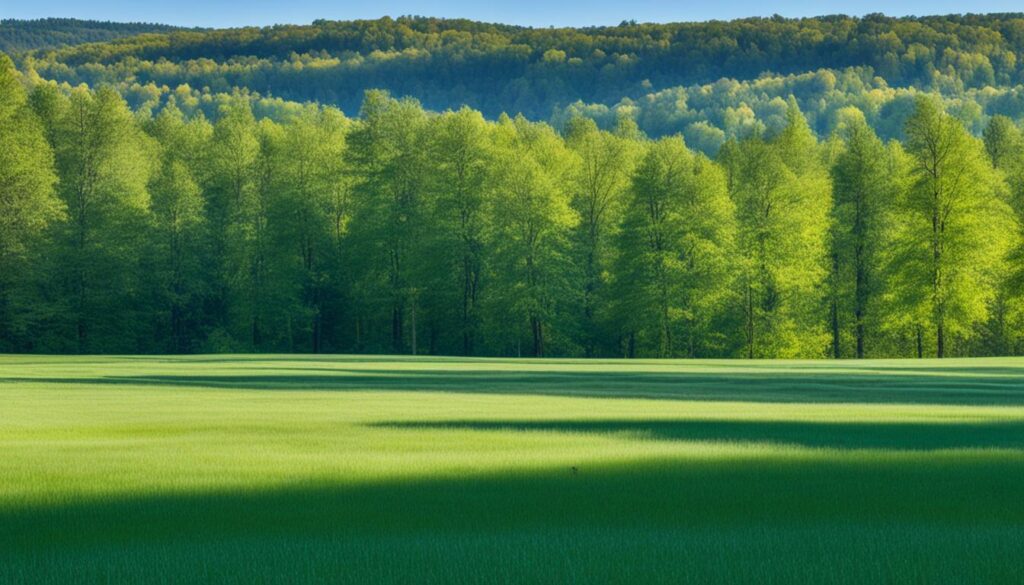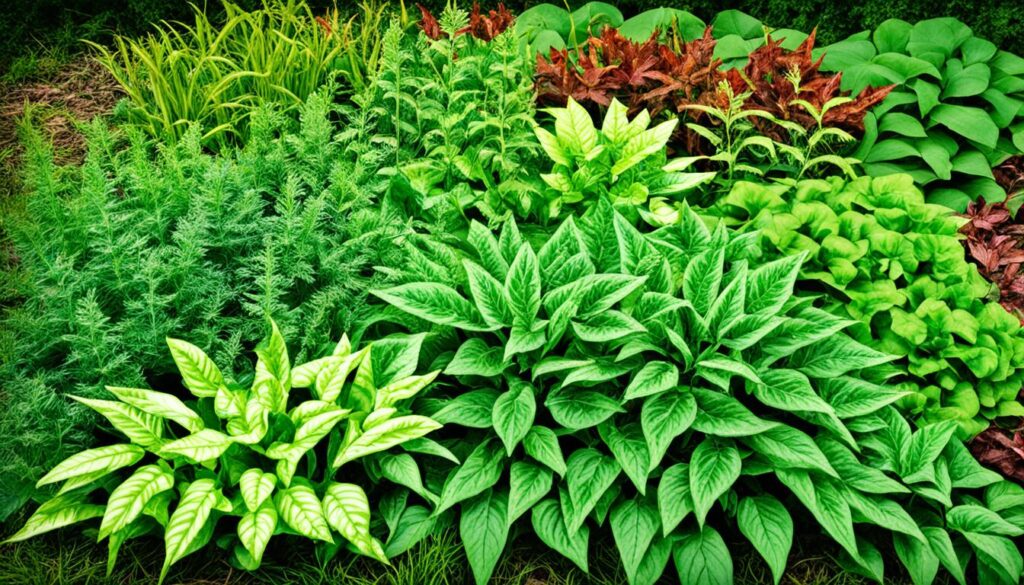Creating the best food plot for deer requires careful consideration of the location, plant selection, and maintenance strategies. By taking these factors into account, you can establish a thriving food plot that attracts and sustains deer on your property.
When it comes to food plot selection for deer, the ideal location is key. Factors such as hunting strategies, access, wind direction, and proximity to bedding areas should all be taken into consideration. By strategically choosing the location, you can maximize the effectiveness of your food plot and create ideal hunting opportunities.
Equally important is selecting the right plants for your deer food plot. Clover, chicory, brassicas, soybeans, and grains are among the top choices for providing a diverse and nutritious food source throughout the year. By planting a mix of annuals and perennials, you can ensure a continuous food supply for deer.
Maintaining your deer food plot is crucial for its long-term success. Regular mowing, weed control, and fertilization are essential tasks to keep the plot healthy and thriving. Additionally, supplementing the plot with extra feed during periods of low productivity can help fill nutritional gaps.
By implementing a strategic food plot strategy and observing deer behavior, you can establish a successful deer food plot that attracts and sustains these majestic animals on your land. With proper planning and maintenance, your food plot can become a haven for deer and a hunting paradise for you.
Content Highlights
ToggleKey Takeaways:
- Choose the food plot location carefully, considering hunting strategies and factors like access, wind direction, and proximity to bedding areas.
- Select a diverse range of plants, such as clover, chicory, brassicas, soybeans, and grains, to provide a nutritious food source throughout the year.
- Maintain your food plot through regular mowing, weed control, fertilization, and supplemental feeding when necessary.
- Observe deer behavior and adapt your strategies accordingly to maximize the effectiveness of your deer food plot.
- Proper planning and maintenance can lead to a successful deer food plot that attracts and sustains deer on your property.
Choosing the Perfect Location for Your Deer Food Plot
The success of a deer food plot depends greatly on the location you choose. Understanding the behavior and habits of deer is key to selecting the ideal plot location. Deer are known for their crepuscular feeding patterns, being most active during dawn and dusk. They also exhibit seasonal movements, such as the rutting season.
When considering suitable habitats for deer food plots, it’s important to take into account their preferred feeding areas and movement patterns. Forested areas, agricultural lands, and transitional zones are common habitats for deer, each offering unique advantages for food plot placement. For example, forested areas provide cover and security, while agricultural lands offer readily available food sources. Transitional zones between different habitat types may attract deer as they move from one area to another.
Environmental factors also play a crucial role in determining the ideal location for your deer food plot. Factors such as soil type, sunlight availability, and water sources should all be considered. Deer food plots thrive in areas with well-drained soil, moderate sunlight, and nearby water sources. Analyzing these environmental factors can help you identify prime locations for your food plots.
To better understand deer movement patterns and suitable habitats for food plots, it’s beneficial to gather data through trail cameras and observations. This allows you to identify high-traffic areas and patterns, helping you choose the most strategic location.
By carefully selecting the perfect location for your deer food plot, taking into account deer behavior and environmental factors, you can significantly increase the effectiveness and success of your plot.

| Factor | Considerations |
|---|---|
| Soil Type | Well-drained soil, suitable nutrient levels |
| Sunlight Availability | Moderate sunlight for optimal plant growth |
| Water Sources | Nearby water sources for deer to access |
Selecting the Right Plants for Your Deer Food Plot
Choosing the right plants is crucial for attracting and sustaining deer on your property. By incorporating a mix of annuals and perennials into your deer food plot, you can provide a diverse and nutritious food source that will keep deer coming back throughout the year.
Some popular plant choices for deer food plots include:
- Clover: Clover is a highly desirable perennial plant that offers excellent nutrition for deer. It provides both high protein content and palatability, making it a favorite choice for many deer hunters and land managers.
- Chicory: Chicory is another perennial plant that deer find irresistible. It has deep taproots that allow it to withstand drought conditions, making it an ideal choice for areas with low water availability.
- Brassicas: Brassicas, such as turnips and rape, are annual plants that are known for their high energy content. They provide a valuable food source during the late season when other plants have diminished nutritional value.
- Soybeans and grains: Planting soybeans and grains like corn and wheat can also attract and sustain deer in your food plot. These annual crops offer a wide range of nutrition and are suitable for both cool-season and warm-season planting.
When it comes to planting timing, it’s important to consider the planting windows for cool-season and warm-season crops. Cool-season crops, like clover and brassicas, should be planted in late summer or early fall, while warm-season crops, such as soybeans and grains, should be planted in spring.
Crop rotation is another essential strategy to maintain a healthy deer food plot. By rotating the types of plants you grow in your plot, you can prevent nutrient depletion in the soil and promote better overall plant growth and deer attraction.
Benefits of Planting Annuals and Perennials
Planting both annuals and perennials in your deer food plot offers several benefits. Annuals provide quick growth and high-energy food sources, while perennials offer sustained nutrition year after year. This combination ensures that your food plot remains productive throughout the changing seasons, attracting deer throughout the year.

With careful selection of deer food plot plants, proper planting timing, and the implementation of crop rotation, you can create a food plot that not only attracts deer but also provides them with the nutrition they need for optimal health and growth.
Maintaining and Maximizing Your Deer Food Plot
Regular maintenance is crucial for the success of your deer food plot. By following these essential food plot maintenance tips, you can create an optimal environment that attracts and sustains deer on your property.
One important aspect of maintenance is mowing and upkeep. Maintaining the desired plant height is crucial to ensure a healthy and attractive food plot. Regular mowing helps control weed competition, allowing your chosen deer food plot plants to thrive. You can also consider rotational mowing, which can help stimulate growth and create diverse habitat options for deer.
In addition to mowing, supplemental feeding plays a significant role in filling nutritional gaps when the food plot production is not as abundant. Supplemental feeding can help maintain the overall health and well-being of the deer population, ensuring they have access to the nutrients they need, especially during periods of low natural food availability.
Creating hunting opportunities within your food plot is another way to maximize its benefits. By strategically designing the layout and placement of tree stands or ground blinds, you can optimize your chances of observing deer behavior and successfully harvesting your target game. This not only enhances the overall hunting experience but also increases the effectiveness of your food plot.
Observing deer behavior is key to adapting your strategies and maximizing the effectiveness of your deer food plot. By understanding their movement patterns, preferences, and feeding habits, you can make informed decisions about when to hunt, adjust feeding schedules, and fine-tune your maintenance practices. This proactive approach ensures the long-term success of your deer food plot and helps create an ideal hunting environment that attracts and sustains a healthy deer population on your property.
FAQ
What factors should I consider when selecting the location for my deer food plot?
When choosing the location for your deer food plot, consider factors such as hunting strategies, access, wind direction, proximity to bedding areas, and deer behavior.
What are suitable habitats for deer food plots?
Forested areas, agricultural lands, and transitional zones are common habitats for deer and offer different advantages for establishing a deer food plot.
Which plants should I include in my deer food plot?
Consider planting a mix of annuals and perennials, such as clover, chicory, brassicas, soybeans, and grains, to provide a diverse and nutritious food source throughout the year.
When should I plant my deer food plot?
Planting timing varies depending on the type of crops. Cool-season crops should be planted in early fall, while warm-season crops should be planted in late spring or early summer.
How can I maintain my deer food plot for optimal growth?
Regular maintenance tasks include mowing to maintain plant height, controlling weed competition, fertilizing as needed, and practicing crop rotation to avoid soil nutrient depletion.
Is supplemental feeding necessary for a deer food plot?
Supplemental feeding can be beneficial when the food plot is not as productive, helping to fill nutritional gaps and attract deer to the area.
How can I create hunting opportunities with my deer food plot?
By strategically designing your food plot and placing tree stands or ground blinds, you can create hunting opportunities and increase your chances of success.
How important is it to observe deer behavior when managing a deer food plot?
Observing deer behavior and adapting your strategies based on their preferences is crucial to maximizing the effectiveness of your deer food plot and attracting more deer to your property.
- California Deer Hunting Guide: Seasons, Rules, Permits, and More - 26 June 2024
- Arkansas Deer Season 2024 [Schedules, Licenses, Bag Limits & More!] - 26 June 2024
- 2024 Arizona Deer Season New Dates & Rules! - 25 June 2024


